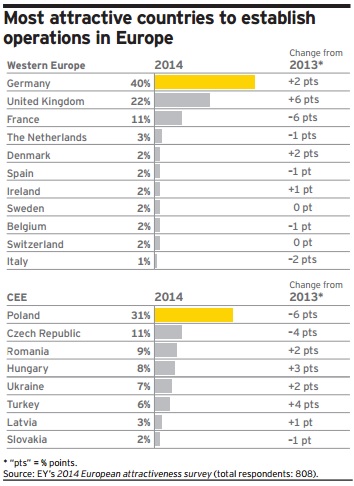Romania gets closer to second place among most attractive countries for business in Central & Eastern Europe

When asked which they think is the most attractive country to establish operations in Central and Eastern Europe (CEE), 9 percent of a survey's respondents answered Romania, according to EY’s 2014 European attractiveness survey.
This is 2 percentage points more than in 2013 and keeps Romania on third place in the region’s ranking, after Poland and Czech Republic, but ahead of Hungary, Ukraine and Turkey.
More importantly, Romania lowered the gap which separates it from second place, which is Czech Republic, who lost 4 percent compared to last year. This year, 11 percent of the 808 investors who answered to this survey said they like the country. Poland is also losing its appeal and lost 6 percentage points this year, which now gives it at 31 percent of total votes.
When it comes to actual real investments, things are a little different. Last year, Romania didn’t make it to Top 15 countries in Europe by the number of foreign direct investments projects (FDI). The countries in the region with the most FDI projects last year were Russia, with 114 projects, Poland (107), Turkey (98), Serbia (63) and Czech Republic (60).
However, Romania made the European Top 10 on the number of jobs created by FDI projects, with 6,157 jobs last year, which is 13 percent fewer than in 2012. But Romania still lags behind countries such as Poland, which is number 3 in Europe, with 13,862 jobs created in 2013, Russia (13,621), Serbia (12,179) and Turkey (8,776).
The EY report also shows that Romania and other countries in the region had a lot less FDI projects in the last five years, between 2009 and 2013, the years post economic crisis, compared to the previous five years (2004-2008), which were the boom years. Romania, Hungary and Bulgaria had almost twice fewer projects. Only Russia, Turkey and Serbia saw an increase in FDI projects during the analyzed period.
“In the early 2000s, many CEE countries emerged as solid growth stories, anchored by an affordable and skilled labor force, a favorable business environment, an advantageous location on the periphery of Europe, and the promise of EU accession. This led to a flood of foreign investments in the region, which increased steadily throughout the pre-crisis period. However, as the crisis spread and underlying weaknesses in some CEE countries came to the fore, the momentum of FDI slowed in some countries, including Poland, the Czech Republic, Hungary, Slovakia, Romania and Bulgaria,” the study concludes, signaling the end of the Central and Eastern European “miracle”.
You can find the complete report here. (in pdf, in English)
Andrei Chirileasa, andrei@romania-insider.com













